Search Result
Results for "
cardioprotective activity
" in MedChemExpress (MCE) Product Catalog:
1
Biochemical Assay Reagents
2
Isotope-Labeled Compounds
| Cat. No. |
Product Name |
Target |
Research Areas |
Chemical Structure |
-
- HY-N0596
-
|
20(R)-Panaxadiol
|
PD-1/PD-L1
HIF/HIF Prolyl-Hydroxylase
STAT
|
Cancer
|
|
Panaxadiol (20(R)-Panaxadiol) is an orally active HIF-1α/STAT3 inhibitor. Panaxadiol can suppress HIF-1α and STAT3 then lead to downregulation of programmed cell death-ligand 1 (PD-L1) expression. Panaxadiol shows anticancer, cardioprotective, anti-arrhythmic, and antioxidative activities .
|
-
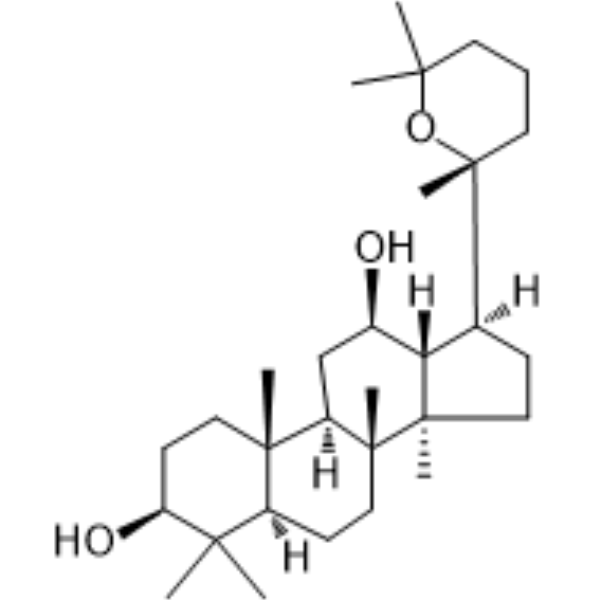
-
- HY-N0055
-
|
3-O-Caffeoylquinic acid; Heriguard; NSC-407296
|
HIF/HIF Prolyl-Hydroxylase
Reactive Oxygen Species
Bacterial
Influenza Virus
Endogenous Metabolite
|
Infection
Inflammation/Immunology
Cancer
|
|
Chlorogenic acid is a major phenolic compound in Lonicera japonica Thunb. It is an orally active antioxidant activity, antibacterial, hepatoprotective, cardioprotective, anti-inflammatory, antipyretic, neuroprotective, anti-obesity, antiviral, anti-microbial, anti-hypertension compound .
|
-

-
- HY-157448
-
|
|
Apoptosis
|
Cancer
|
|
CBR1-IN-6 (compound 1a) is a CBR1 inhibitor with chemosensitizing and cardioprotective activities .
|
-
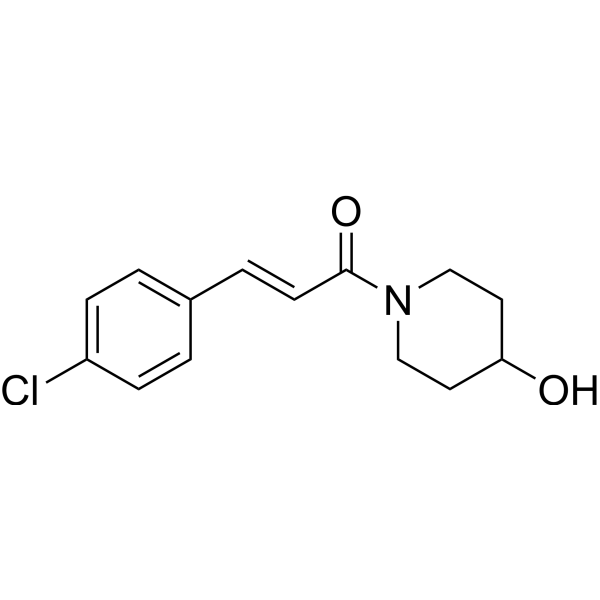
-
- HY-N6033
-
|
(+)-Ferruginol
|
EBV
HSV
Apoptosis
|
Infection
Cardiovascular Disease
Neurological Disease
Cancer
|
|
Ferruginol ((+)-Ferruginol), a natural diterpenoid, is an inhibitor of the activation of Epstein-Barr virus early antigen (EBV-EA). Ferruginol inhibits the growth of thyroid cancer cells through the induction of mitochondrial apoptosis. Ferruginol has antitumor, cardioprotective, antioxidant, gastroprotective, and neuroprotective activities .
|
-
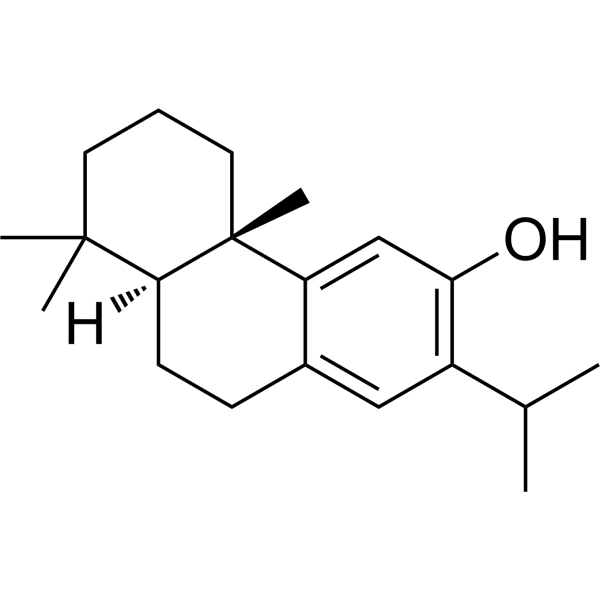
-
- HY-U00354
-
-

-
- HY-19396
-
|
CP 368296; GPi 296
|
|
|
|
Ingliforib (CP 368296) is a glycogen phosphorylase inhibitor, with IC50s of 52, 352 and 150 nM for liver, muscle and brain glycogen phosphorylase, and has cardioprotective activity.
|
-
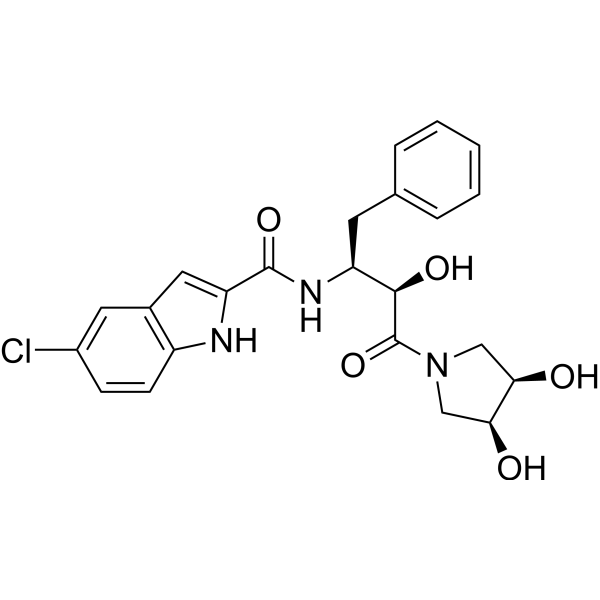
-
- HY-N1214
-
|
Super Squalene; trans-Squalene; AddaVax
|
|
|
|
Squalene (Super Squalene) is an intermediate product in the synthesis of cholesterol, and shows several pharmacological properties such as hypolipidemic, hepatoprotective, antiatherosclerotic, cardioprotective, antioxidant, and antitumour activity .
|
-
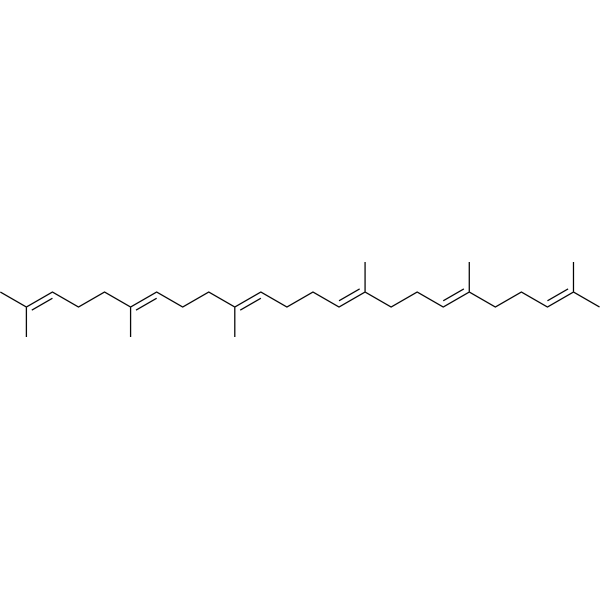
-
- HY-N7697D
-
-
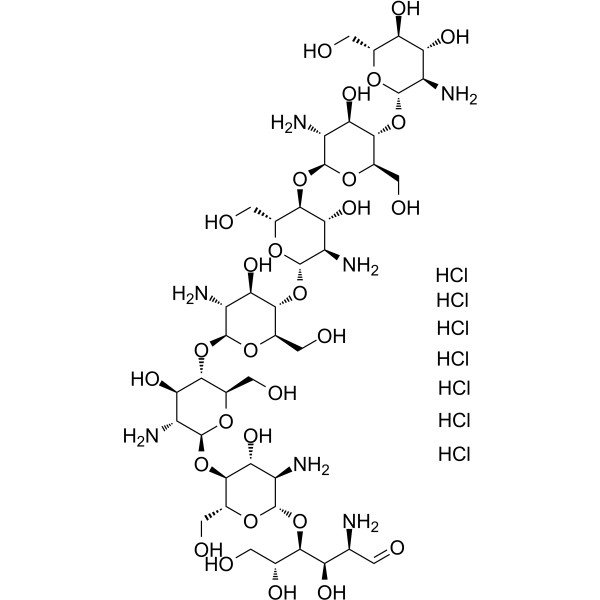
-
- HY-W013075
-
|
Rutoside trihydrate; Quercetin 3-O-rutinoside trihydrate
|
Apoptosis
Endogenous Metabolite
|
Neurological Disease
Cancer
|
|
Rutin (Rutoside) trihydrate is a multifunctional natural flavonoid glycoside. Rutin trihydrate has been demonstrating excellent antioxidant, anti-inflammatory, anti-diabetic, and anti-carcinogenic properties. Cardioprotective and neuroprotective activities .
|
-
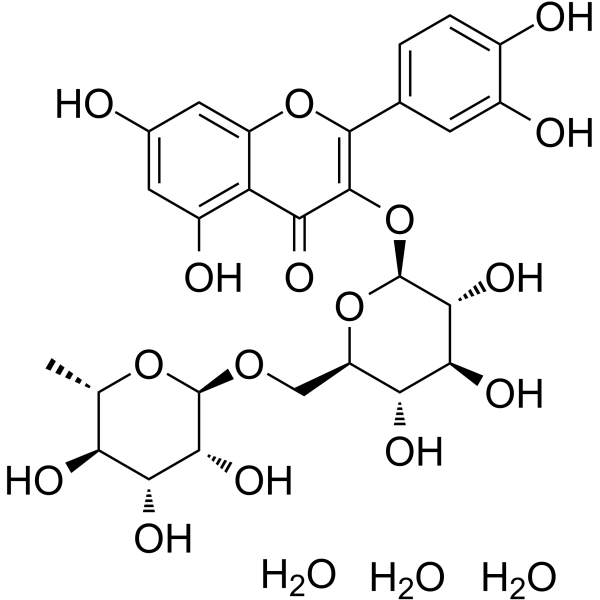
-
- HY-N1214S
-
|
Super Squalene-d6; trans-Squalene-d6; AddaVax-d6
|
Isotope-Labeled Compounds
|
Others
|
|
Squalene-d6 is a deuterium labeled Squalene. Squalene (Super Squalene) is an intermediate product in the synthesis of cholesterol, and shows several pharmacological properties such as hypolipidemic, hepatoprotective, antiatherosclerotic, cardioprotective, antioxidant, and antitumour activity .
|
-

-
- HY-N8754
-
|
|
Others
|
Cardiovascular Disease
Cancer
|
|
(7S)-Dalbergiphenol is a cytotoxic compound that can be isolated from Brazilian red propoli. (7S)-Dalbergiphenol inhibits cancer cell viability. Brazilian red propoli has cardioprotective activity .
|
-

-
- HY-108502
-
|
|
Sodium Channel
|
Cardiovascular Disease
|
|
KC 12291 hydrochloride is an orally active blocker of voltage-gated sodium channel (VGSC). KC 12291 hydrochloride reduces the amplitude of sustained Na + current to exert antiischemic activity. KC 12291 hydrochloride has significant cardioprotective effect in vitro and in vivo .
|
-

-
- HY-121710
-
|
7-Monohydroxyethylrutoside
|
Others
|
Cardiovascular Disease
|
|
MonoHER (7-Monohydroxyethylrutoside) is a Carbonyl reductase 1 (CBR1) inhibitor and can be used as a cardioprotective agent. MonoHER inhibits the activity of CBR1 V88 and CBR1 I88 in a concentration-dependent manner .
|
-
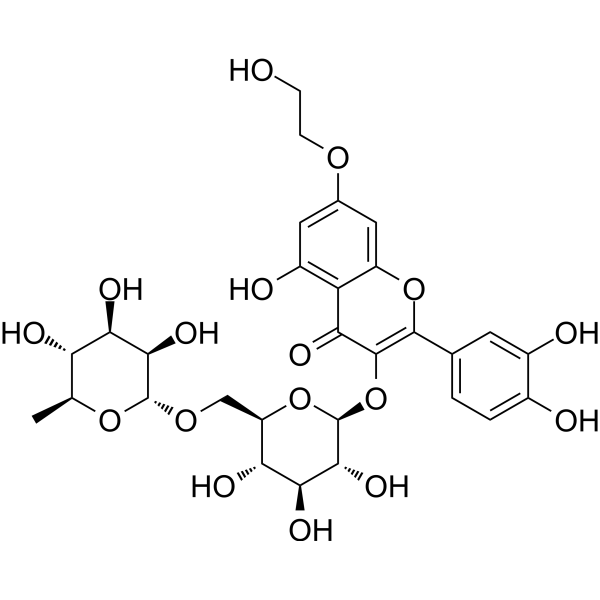
-
- HY-19463A
-
|
|
Sodium Channel
|
Cardiovascular Disease
|
|
F 15845 is a highly effective persistent sodium current blocker. F 15845 also is a cardioprotective agent, has anti-ischemic activity and exerts short- and long-term cardioprotection after myocardial infarction. F 15845 can be used for the research of myocardium functional impairment .
|
-
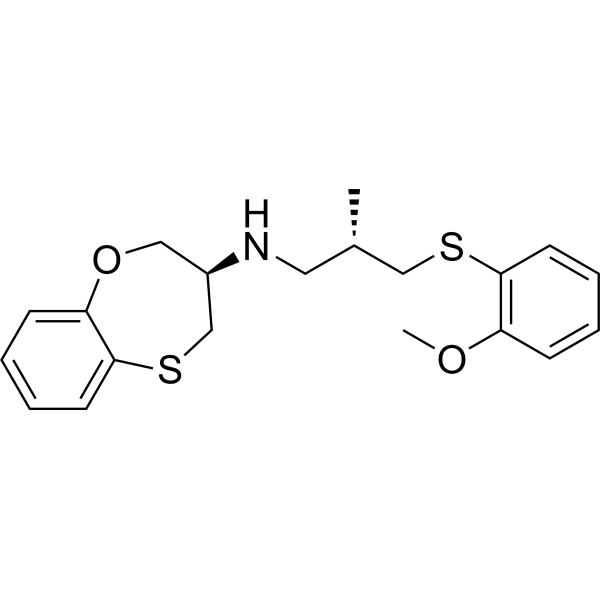
-
- HY-N0368
-
-
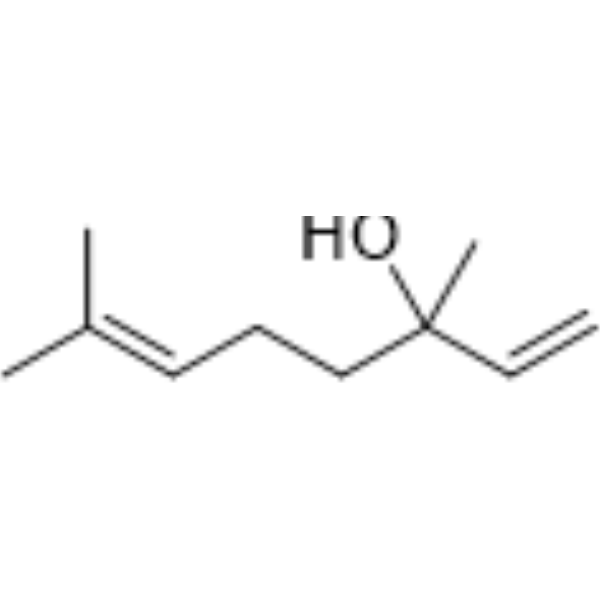
-
- HY-N0120
-
|
(E/Z)-Piceid
|
Others
|
Inflammation/Immunology
|
|
(E/Z)-Polydatin ((E/Z)-Piceid) is a monocrystalline compound originally isolated from the root and rhizome of Polygonum cuspidatum. (E/Z)-Polydatin has anti-platelet aggregation, anti-oxidative action of low-density lipoprotein (LDL), cardioprotective activity, anti-inflammatory and immune-regulating functions .
|
-
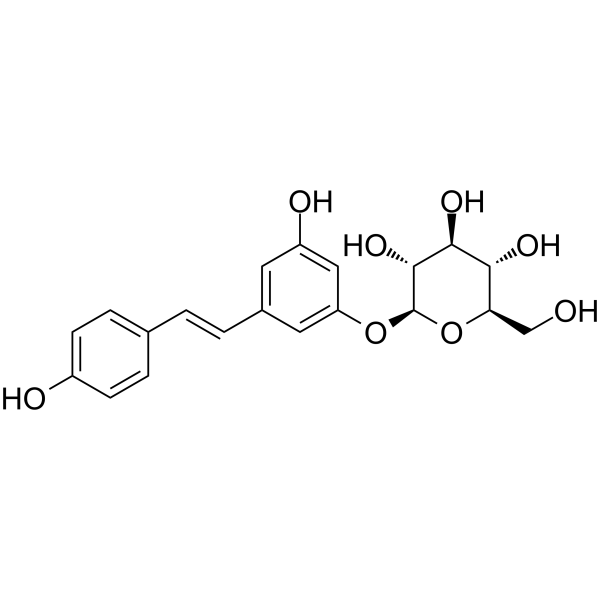
-
- HY-N0345
-
|
|
Others
|
Inflammation/Immunology
Cancer
|
|
Liriope muscari baily saponins C is one of major active compounds of L. muscari (Decne.) Baily. Liriope muscari baily saponins C possesses strong anti-inflammatory, immunopharmacological and cardioprotective activities. Liriope muscari baily saponins C has been studied as a candidate agent for cancer metastasis .
|
-
![(3β,25S)-Spirost-5-en-3-yl O-6-deoxy-α-L-mannopyranosyl-(1→2)-O-[β-D-xylopyranosyl-(1→3)]-β-D-glucopyranoside](//file.medchemexpress.com/product_pic/hy-n0345.gif)
-
- HY-B0655
-
|
SQ26991
|
Angiotensin-converting Enzyme (ACE)
Reactive Oxygen Species
|
Cardiovascular Disease
|
|
Zofenopril Calcium (SQ26991) is an orally active angiotensin-converting enzyme (ACE) inhibitor with antioxidant activity and cardioprotective effects. Zofenopril Calcium reduces ROS production and GSH consumption and helps inhibit foam cell formation, thus slowing the progression of atherosclerosis. Zofenopril Calcium prevents cardiac damage caused by chronic Doxorubicin (HY-15142A).
|
-
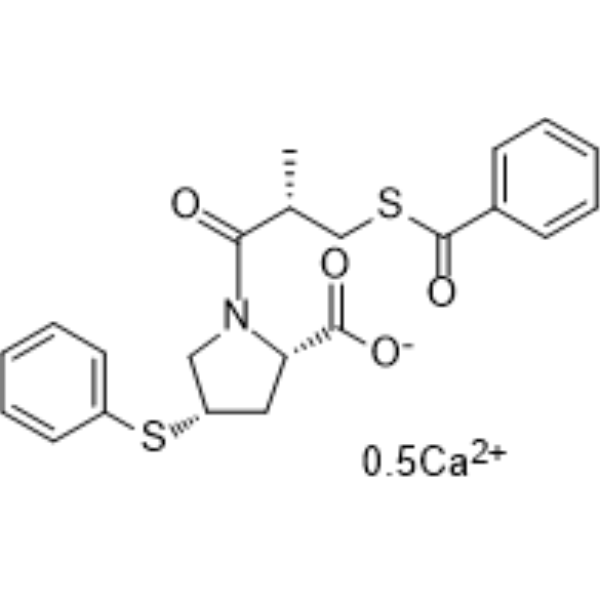
-
- HY-108351
-
|
|
Necroptosis
|
Cardiovascular Disease
|
|
IM-54 is a selective inhibitor of oxidative stress-induced necrosis. IM-54 shows potent inhibitory activity against H2O2-induced necrosis. IM-54 acts as a potential cardioprotective agent and biological tool for investigating the molecular mechanisms of cell death .
|
-
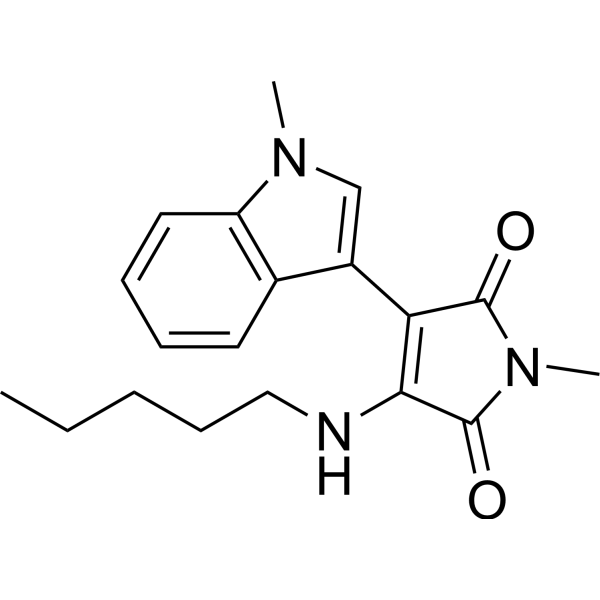
-
- HY-W728451
-
|
|
FAAH
|
Cardiovascular Disease
Neurological Disease
|
|
URB694 is a carbamate FAAH inhibitor that irreversibly carbamoylate the nucleophile catalytic serine in FAAH active site. URB694 exhibits antidepressant-like activity and cardioprotective effects. URB694 can be used to prepare 11C-Carbonyl-URB694 for in vivo positron emission tomography (PET) imaging studies of the brain FAAH .
|
-
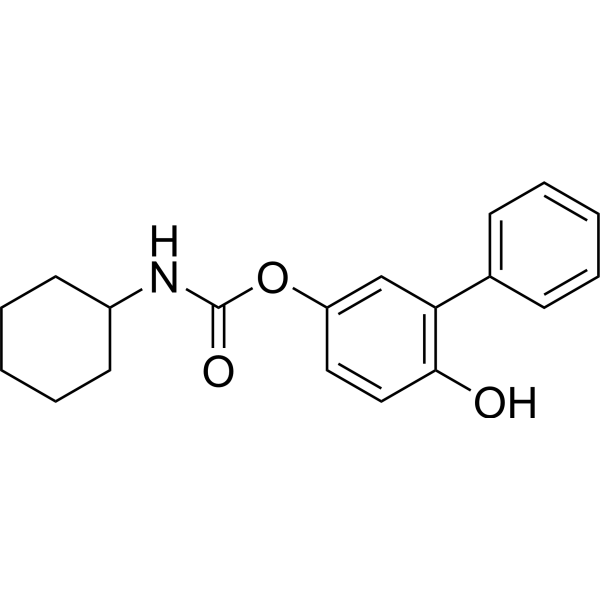
-
- HY-N0213
-
|
Verticinone; Raddeanine
|
Autophagy
Caspase
Bcl-2 Family
PARP
p38 MAPK
ERK
NF-κB
Apoptosis
|
Inflammation/Immunology
Cancer
|
|
Peiminine is a compound that can be isolated from Bolbostemma paniculatum (Maxim) Franquet (Cucurbitaceae family). Peiminine can induce apoptosis in human hepatocellular carcinoma HepG2 cells through both extrinsic and intrinsic apoptotic pathways. Peiminine has anti-inflammatory, anticancer, anti-osteoporosis, cardioprotective and other activities in many animal models .
|
-
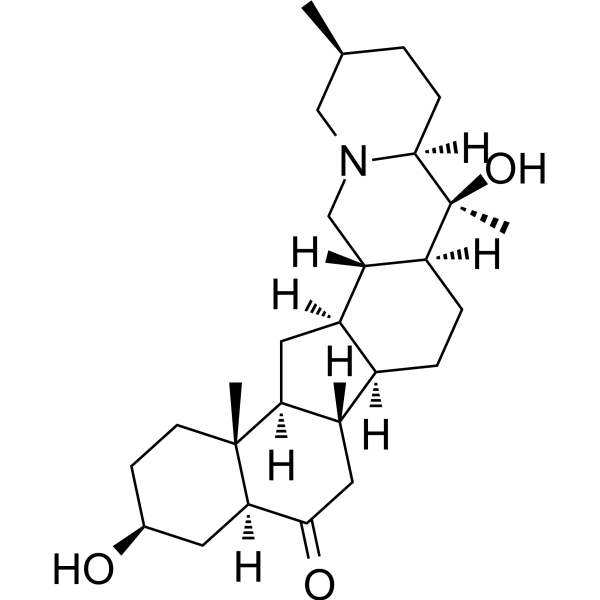
-
- HY-W001538
-
|
SPRC
|
STAT
MDM-2/p53
|
Inflammation/Immunology
|
|
S-Propargylcysteine (SPRC), a structural analog of S-allyl cysteine (SAC), is a slow H2S-releasing compound. S-Propargylcysteine reduces Ca 2+ accumulation and inflammatory cytokines, inhibits STAT3, and elevates p53 and Bax. S-Propargylcysteine has anti-inflammatory activity and protects mice against acute pancreatitis. S-Propargylcysteine also has cardioprotective, neuroprotective acitivties .
|
-

-
- HY-N0055S
-
|
3-O-Caffeoylquinic acid-13C3; Heriguard-13C3; NSC-407296-13C3
|
Isotope-Labeled Compounds
|
Cancer
|
|
Chlorogenic acid- 13C3 (Heriguard- 13C3; NSC-407296- 13C3) is 13C- and 15N-labeled Chlorogenic acid (HY-N0055). Chlorogenic acid is a major phenolic compound in Lonicera japonica Thunb.. It plays several important and therapeutic roles such as antioxidant activity, antibacterial, hepatoprotective, cardioprotective, anti-inflammatory, antipyretic, neuroprotective, anti-obesity, antiviral, anti-microbial, anti-hypertension .
|
-

-
- HY-W145695
-
|
|
Biochemical Assay Reagents
|
Inflammation/Immunology
|
|
Chitoheptaose is a chitosan oligosaccharide. Chitoheptaose is capable of extracting exoskeletons from crustaceans, such as the shells of crabs, shrimp and lobsters. Chitoheptaose has antioxidant, anti-inflammatory and anti-apoptotic activities and can be used in the study of myocarditis. Chitoheptaose has cardioprotective effects and improves cardiac parameters (left ventricular internal size, end-systolic and end-diastolic, ejection fraction and shortening fraction), inflammatory cytokines (IL-1β) in vanishing models .
|
-
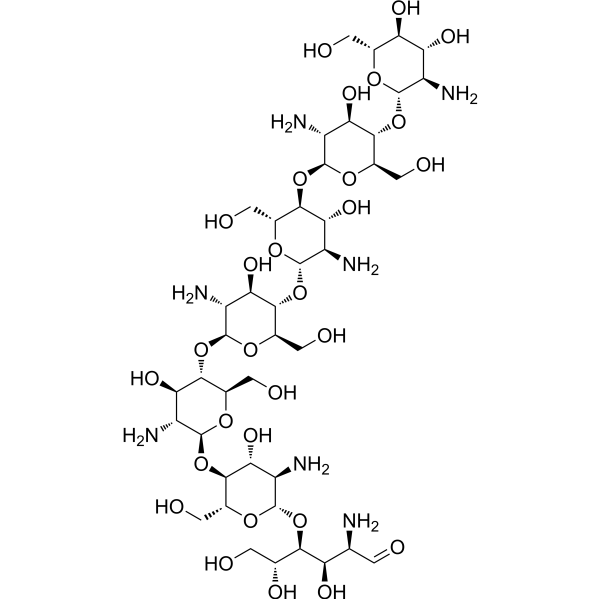
-
- HY-12403A
-
|
TXA127 acetate; Angiotensin (1-7) (acetate); Ang-(1-7) (acetate)
|
Angiotensin Receptor
Angiotensin-converting Enzyme (ACE)
Endogenous Metabolite
|
Cardiovascular Disease
Inflammation/Immunology
Endocrinology
|
|
Angiotensin 1-7 (Ang-(1-7)) acetate is an endogenous heptapeptide from the renin-angiotensin system (RAS) with a cardioprotective role due to its anti-inflammatory and anti-fibrotic activities in cardiac cells. Angiotensin 1-7 acetate inhibits purified canine ACE activity (IC50=0.65 μM). Angiotensin 1-7 acetate acts as a local synergistic modulator of kinin-induced vasodilation by inhibiting ACE and releasing nitric oxide. Angiotensin 1-7 acetate blocks Ang II-induced smooth muscle cell proliferation and hypertrophy and shows antiangiogenic and growth-inhibitory effects on the endothelium .
|
-
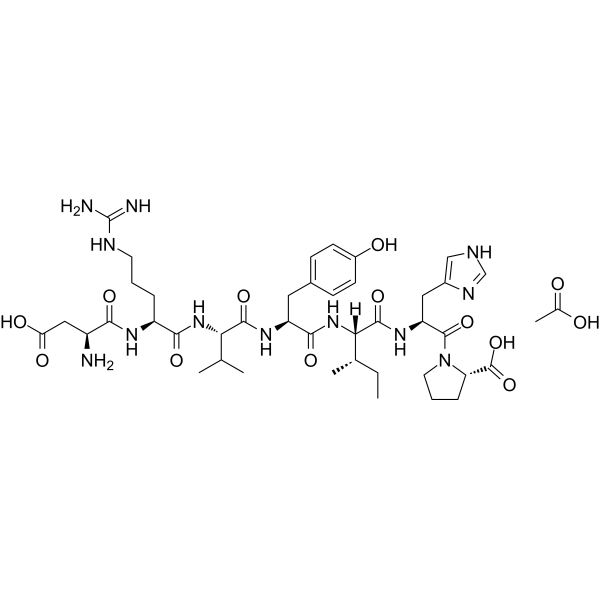
-
- HY-12403
-
|
TXA127; Angiotensin (1-7); Ang-(1-7)
|
Angiotensin Receptor
Angiotensin-converting Enzyme (ACE)
Endogenous Metabolite
|
Cardiovascular Disease
Inflammation/Immunology
Endocrinology
|
|
Angiotensin 1-7 (Ang-(1-7)) is an endogenous heptapeptide from the renin-angiotensin system (RAS) with a cardioprotective role due to its anti-inflammatory and anti-fibrotic activities in cardiac cells. Angiotensin 1-7 inhibits purified canine ACE activity (IC50=0.65 μM). Angiotensin 1-7 acts as a local synergistic modulator of kinin-induced vasodilation by inhibiting ACE and releasing nitric oxide. Angiotensin 1-7 blocks Ang II-induced smooth muscle cell proliferation and hypertrophy and shows antiangiogenic and growth-inhibitory effects on the endothelium. Angiotensin 1-7 shows anti-inflammatory activity .
|
-

-
- HY-125959
-
|
|
Apoptosis
|
Cardiovascular Disease
Neurological Disease
|
|
Ucf-101 is a selective and competitive inhibitor of pro-apoptotic protease Omi/HtrA2, with an IC50 of 9.5 μM for His-Omi. Ucf-101 exhibits very little activity against various other serine proteases (IC50>200 μM). Ucf-101 has a natural red fluorescence at 543 nm that is used to monitor its ability to enter mammalian cells. Ucf-101 has a significant cardioprotective effect against MI/R injury and also has certain neuroprotective effect .
|
-
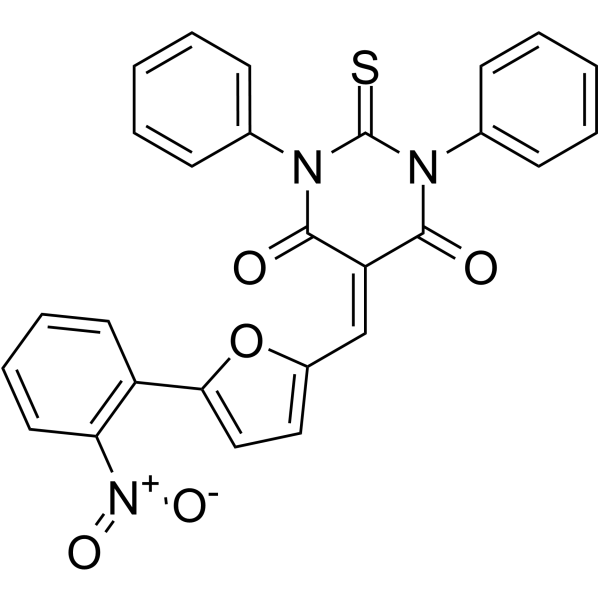
-
- HY-N8380
-
|
|
Apoptosis
Autophagy
PI3K
Necroptosis
|
Cardiovascular Disease
Inflammation/Immunology
Cancer
|
|
(-)-Latifolin, a flavonoid, induces apoptotic cell death by targeting PI3K/AKT/mTOR/p70S6K signaling. (-)-Latifolin significantly inhibits the cell proliferation of oral squamous cell carcinoma (OSCC), and causes the anti-metastatic activities by effectively blocking cell migration, invasion, and adhesion via the inactivation of FAK/Src. (-)-Latifolin suppresses autophagic-related proteins and autophagosome formation. (-)-Latifolin inhibits necroptosis by dephosphorylating necroptosis-regulatory proteins (RIP1, RIP3, and MLKL). (-)-Latifolin has beneficial effects on anti-aging, anti-carcinogenic, anti-inflammatory, and cardio-protective activities .
|
-

| Cat. No. |
Product Name |
Type |
-
- HY-W145695
-
|
|
Biochemical Assay Reagents
|
|
Chitoheptaose is a chitosan oligosaccharide. Chitoheptaose is capable of extracting exoskeletons from crustaceans, such as the shells of crabs, shrimp and lobsters. Chitoheptaose has antioxidant, anti-inflammatory and anti-apoptotic activities and can be used in the study of myocarditis. Chitoheptaose has cardioprotective effects and improves cardiac parameters (left ventricular internal size, end-systolic and end-diastolic, ejection fraction and shortening fraction), inflammatory cytokines (IL-1β) in vanishing models .
|
| Cat. No. |
Product Name |
Target |
Research Area |
-
- HY-12403A
-
|
TXA127 acetate; Angiotensin (1-7) (acetate); Ang-(1-7) (acetate)
|
Angiotensin Receptor
Angiotensin-converting Enzyme (ACE)
Endogenous Metabolite
|
Cardiovascular Disease
Inflammation/Immunology
Endocrinology
|
|
Angiotensin 1-7 (Ang-(1-7)) acetate is an endogenous heptapeptide from the renin-angiotensin system (RAS) with a cardioprotective role due to its anti-inflammatory and anti-fibrotic activities in cardiac cells. Angiotensin 1-7 acetate inhibits purified canine ACE activity (IC50=0.65 μM). Angiotensin 1-7 acetate acts as a local synergistic modulator of kinin-induced vasodilation by inhibiting ACE and releasing nitric oxide. Angiotensin 1-7 acetate blocks Ang II-induced smooth muscle cell proliferation and hypertrophy and shows antiangiogenic and growth-inhibitory effects on the endothelium .
|
-
- HY-12403
-
|
TXA127; Angiotensin (1-7); Ang-(1-7)
|
Angiotensin Receptor
Angiotensin-converting Enzyme (ACE)
Endogenous Metabolite
|
Cardiovascular Disease
Inflammation/Immunology
Endocrinology
|
|
Angiotensin 1-7 (Ang-(1-7)) is an endogenous heptapeptide from the renin-angiotensin system (RAS) with a cardioprotective role due to its anti-inflammatory and anti-fibrotic activities in cardiac cells. Angiotensin 1-7 inhibits purified canine ACE activity (IC50=0.65 μM). Angiotensin 1-7 acts as a local synergistic modulator of kinin-induced vasodilation by inhibiting ACE and releasing nitric oxide. Angiotensin 1-7 blocks Ang II-induced smooth muscle cell proliferation and hypertrophy and shows antiangiogenic and growth-inhibitory effects on the endothelium. Angiotensin 1-7 shows anti-inflammatory activity .
|
| Cat. No. |
Product Name |
Category |
Target |
Chemical Structure |
-
- HY-N0596
-
-

-
- HY-N0055
-
|
3-O-Caffeoylquinic acid; Heriguard; NSC-407296
|
Structural Classification
Caprifoliaceae
Classification of Application Fields
Anti-aging
Lonicera japonica Thunb.
Source classification
Plants
Endogenous metabolite
Infection
Human Gut Microbiota Metabolites
Microorganisms
Simple Phenylpropanols
Phenols
Polyphenols
Phenylpropanoids
Inflammation/Immunology
Disease Research Fields
Cancer
|
HIF/HIF Prolyl-Hydroxylase
Reactive Oxygen Species
Bacterial
Influenza Virus
Endogenous Metabolite
|
|
Chlorogenic acid is a major phenolic compound in Lonicera japonica Thunb. It is an orally active antioxidant activity, antibacterial, hepatoprotective, cardioprotective, anti-inflammatory, antipyretic, neuroprotective, anti-obesity, antiviral, anti-microbial, anti-hypertension compound .
|
-

-
- HY-W013075
-
-

-
- HY-N6033
-
-

-
- HY-N7697D
-
-

-
- HY-N8754
-
-

-
- HY-N0368
-
-

-
- HY-N0120
-
-

-
- HY-N0345
-
-
![(3β,25S)-Spirost-5-en-3-yl O-6-deoxy-α-L-mannopyranosyl-(1→2)-O-[β-D-xylopyranosyl-(1→3)]-β-D-glucopyranoside](//file.medchemexpress.com/product_pic/hy-n0345.gif)
-
- HY-N0213
-
-

-
- HY-12403A
-
-

-
- HY-12403
-
-

-
- HY-N8380
-
|
|
Structural Classification
Dalbergia hupeana Hance
Source classification
Phenols
Polyphenols
Plants
Fabaceae
|
Apoptosis
Autophagy
PI3K
Necroptosis
|
|
(-)-Latifolin, a flavonoid, induces apoptotic cell death by targeting PI3K/AKT/mTOR/p70S6K signaling. (-)-Latifolin significantly inhibits the cell proliferation of oral squamous cell carcinoma (OSCC), and causes the anti-metastatic activities by effectively blocking cell migration, invasion, and adhesion via the inactivation of FAK/Src. (-)-Latifolin suppresses autophagic-related proteins and autophagosome formation. (-)-Latifolin inhibits necroptosis by dephosphorylating necroptosis-regulatory proteins (RIP1, RIP3, and MLKL). (-)-Latifolin has beneficial effects on anti-aging, anti-carcinogenic, anti-inflammatory, and cardio-protective activities .
|
-

| Cat. No. |
Product Name |
Chemical Structure |
-
- HY-N1214S
-
|
|
|
Squalene-d6 is a deuterium labeled Squalene. Squalene (Super Squalene) is an intermediate product in the synthesis of cholesterol, and shows several pharmacological properties such as hypolipidemic, hepatoprotective, antiatherosclerotic, cardioprotective, antioxidant, and antitumour activity .
|
-

-
- HY-N0055S
-
|
|
|
Chlorogenic acid- 13C3 (Heriguard- 13C3; NSC-407296- 13C3) is 13C- and 15N-labeled Chlorogenic acid (HY-N0055). Chlorogenic acid is a major phenolic compound in Lonicera japonica Thunb.. It plays several important and therapeutic roles such as antioxidant activity, antibacterial, hepatoprotective, cardioprotective, anti-inflammatory, antipyretic, neuroprotective, anti-obesity, antiviral, anti-microbial, anti-hypertension .
|
-

| Cat. No. |
Product Name |
|
Classification |
-
- HY-W001538
-
|
SPRC
|
|
Alkynes
|
|
S-Propargylcysteine (SPRC), a structural analog of S-allyl cysteine (SAC), is a slow H2S-releasing compound. S-Propargylcysteine reduces Ca 2+ accumulation and inflammatory cytokines, inhibits STAT3, and elevates p53 and Bax. S-Propargylcysteine has anti-inflammatory activity and protects mice against acute pancreatitis. S-Propargylcysteine also has cardioprotective, neuroprotective acitivties .
|
Your information is safe with us. * Required Fields.
Inquiry Information
- Product Name:
- Cat. No.:
- Quantity:
- MCE Japan Authorized Agent:






















![(3β,25S)-Spirost-5-en-3-yl O-6-deoxy-α-L-mannopyranosyl-(1→2)-O-[β-D-xylopyranosyl-(1→3)]-β-D-glucopyranoside](http://file.medchemexpress.com/product_pic/hy-n0345.gif)













